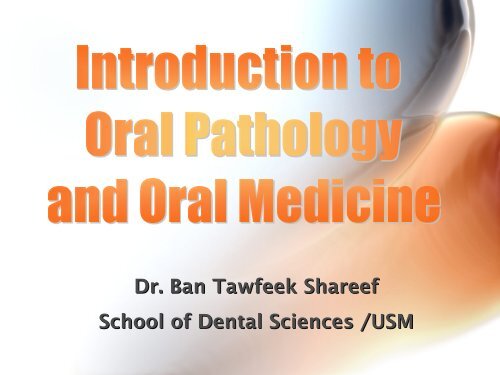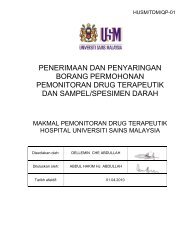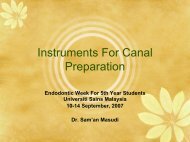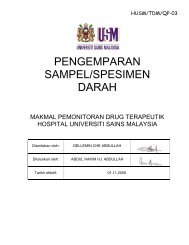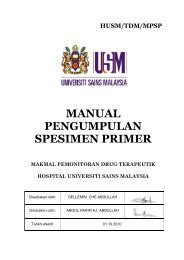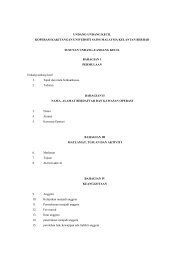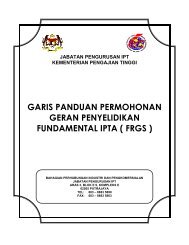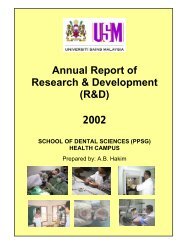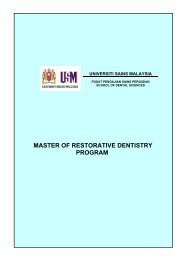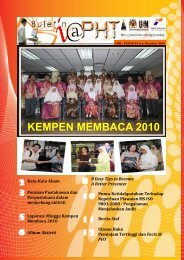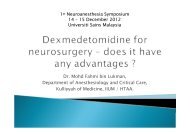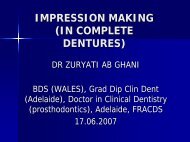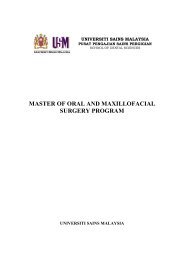Dr. Ban Tawfeek Shareef School of Dental Sciences /USM
Dr. Ban Tawfeek Shareef School of Dental Sciences /USM
Dr. Ban Tawfeek Shareef School of Dental Sciences /USM
You also want an ePaper? Increase the reach of your titles
YUMPU automatically turns print PDFs into web optimized ePapers that Google loves.
<strong>Dr</strong>. <strong>Ban</strong> <strong>Tawfeek</strong> <strong>Shareef</strong><br />
<strong>School</strong> <strong>of</strong> <strong>Dental</strong> <strong>Sciences</strong> /<strong>USM</strong>
• Oral pathology in General , is the<br />
study <strong>of</strong> diseases affecting the oral<br />
cavity.<br />
• Oral Pathology emphasizes diseases<br />
that do not affect teeth or<br />
periodontium
Clinical Oral pathology<br />
• It<br />
It is the specialty <strong>of</strong> dentistry and pathology<br />
which deals with the nature, identification, and<br />
management <strong>of</strong> diseases affecting the oral and<br />
maxill<strong>of</strong>acial regions.<br />
• It is a science that investigates the causes,<br />
processes and effects <strong>of</strong> these diseases.<br />
• The practice <strong>of</strong> oral pathology includes research,<br />
diagnosis <strong>of</strong> diseases using clinical,<br />
radiographic, microscopic, biochemical or other<br />
examinations, and management <strong>of</strong> patients.
Oral pathology ( (medicine)<br />
• It is a branch <strong>of</strong> dentistry that is<br />
concerned with the diseases <strong>of</strong> the<br />
teeth, oral cavity, and jaws, and with<br />
the oral manifestations <strong>of</strong> systemic<br />
diseases.
The Significance <strong>of</strong> Oral Pathology in <strong>Dental</strong> Practice<br />
‣Oral pathologists are not needed to make<br />
diagnoses <strong>of</strong> common diseases (period &<br />
pulp disease , caries ).<br />
-Those Common diseases can easily be<br />
identified (clinical & radiographic exam. )<br />
by general dentist & the concerned<br />
specialists .
‣ Oral pathologists are needed to make<br />
diagnoses <strong>of</strong> other diseases( less<br />
common) that may occur from time to time in<br />
dental patients like diseases :<br />
-originate in the oral cavity.<br />
-some may be caused by disease<br />
elsewhere.<br />
-still others may spread to the oral region<br />
from distant sites.
• Serious consequences may occurs if un<br />
common diseases are not recognized,<br />
classified, and treated early.<br />
• However there are problems which make for<br />
microscopic examination mandatory:<br />
‣ First, the early clinical appearance<br />
<strong>of</strong> many conditions are subtle.<br />
‣ Second, more overt clinical features<br />
usually are not distinctive.
How to reach to a definitive diagnosis<br />
• The process <strong>of</strong> diagnosis require<br />
gathering information that relevant to<br />
the patient and the lesion being<br />
evaluated .<br />
• There are eight distinct diagnostic<br />
categories:
The DIAGNOSTIC PROCESS<br />
• Historical Diagnosis<br />
• Clinical diagnosis<br />
• Radiographic Diagnosis<br />
• Laboratory Diagnosis<br />
• Microscopic Diagnosis<br />
• Surgical Diagnosis<br />
• Theraputic Diagnosis<br />
• Differential Diagnosis.
1. Historical Diagnosis<br />
Personal history, family history, past<br />
and present medical and dental<br />
histories, history <strong>of</strong> drug ingestion,<br />
and history <strong>of</strong> the presenting disease<br />
or lesion provides information<br />
necessary for the definitive diagnosis.
2. Clinical Diagnosis<br />
• Clinical Diagnosis is based on<br />
-Clinical examination and palpation to<br />
feel the (consistency ) <strong>of</strong> the lesion.<br />
- Size , color, shape, location, and<br />
history <strong>of</strong> the lesion.
3. Radiographic Diagnosis<br />
• Radiograph(s) provides<br />
sufficient information to<br />
establish the diagnosis.
4. Laboratory Diagnosis<br />
•Diagnostic laboratory tests<br />
including blood chemistries and<br />
urinalysis, can provide conclusive<br />
information for a definitive<br />
diagnosis.
5. Microscopic Diagnosis<br />
• Evaluation <strong>of</strong> a biopsy specimen<br />
taken from the lesion is <strong>of</strong>ten the<br />
main component <strong>of</strong> the definitive<br />
diagnosis.
6. Surgical Diagnosis<br />
• Surgical intervention provides<br />
conclusive evidence <strong>of</strong> the<br />
diagnosis when the lesion is<br />
opened.
7. Therapeutic Diagnosis<br />
• Prescribing therapeutic drugs<br />
and observing the results<br />
based on clinical and historical<br />
information.
8.Differential diagnosis<br />
• Rearranging <strong>of</strong> list <strong>of</strong> possible<br />
diagnosis with the most probable<br />
lesion ranked at the top and the<br />
least likely at the bottom.<br />
• The clinician must be familiar<br />
with the signs and symptoms<br />
produced by many diseases .
8.Diff diagn<br />
• The clinician must possess some<br />
statistical knowledge <strong>of</strong> relative<br />
incidence <strong>of</strong> each disease entity.<br />
• The order by frequency may<br />
need to be modified by<br />
consideration <strong>of</strong> age, gender,<br />
race, country <strong>of</strong> origin, and<br />
anatomical location.
Routine head, neck and<br />
oral cavity examination<br />
procedure
Recommendation for successful exam.<br />
procedure<br />
• The head, neck and oral cavity are areas that<br />
can be easily viewed.<br />
• This simple procedure (Exam. ) may yield<br />
important information regarding the health<br />
status <strong>of</strong> this area <strong>of</strong> the body.<br />
1. Before you can identify a lesion or abnormal<br />
condition, it is necessary to have a solid<br />
understanding <strong>of</strong> the basic and dental<br />
sciences, such as human anatomy and<br />
physiology, histology, and dental anatomy.
2. Once you have a solid understanding<br />
<strong>of</strong> normal structures and those that<br />
are variants <strong>of</strong> normal, findings that<br />
deviate from normal and pathologic<br />
conditions are more easily<br />
recognized.<br />
3. Both abnormal and normal s<strong>of</strong>t<br />
tissue can be inspected visually by<br />
observation and by palpation<br />
;observation is the key in maintaining<br />
oral health.
4. With knowledge <strong>of</strong> what is normal<br />
and <strong>of</strong> what one expects to see, you<br />
can routinely perform a systematic<br />
examination <strong>of</strong> the patient.<br />
5. Using primarily inspection and<br />
palpation, the following method <strong>of</strong><br />
examination is <strong>of</strong>fered as a basis for<br />
establishing a logical order and<br />
sequence.
Extra oral Examination<br />
• Generalized appraisal <strong>of</strong> the patient<br />
Face .<br />
• Submental and submandibular<br />
lymph node areas .<br />
• Parotid area including lymph nodes<br />
.<br />
• Temporomandibular joint area .<br />
• Ears .<br />
• Neck and cervical lymph nodes<br />
including supraclavicular nodes .<br />
• Thyroid gland area .
Facial view shown<br />
essential symmetry. Note<br />
that in this case the left<br />
side <strong>of</strong> the patient's face<br />
looks a bit larger because<br />
the head is turned to the<br />
patient's right side<br />
slightly.<br />
Palpation <strong>of</strong> the submental<br />
lymph node area with firm<br />
pressure and rotating the<br />
finger behind the chin.
Bimanual palpation <strong>of</strong> the<br />
submandibular gland areas for<br />
the gland and for lymph node .
Palpation <strong>of</strong> the<br />
temporomandibular<br />
joints at the tragus <strong>of</strong> the<br />
ear as the patient opens<br />
and closes the mandible.<br />
Bilateral palpation and<br />
gentle squeezing <strong>of</strong> the<br />
sternocleidomastoid<br />
muscle to locate the<br />
cervical chain <strong>of</strong> nodes<br />
just medial and deeper to<br />
the muscle.
Palpation <strong>of</strong> the<br />
supraclavicular area behind<br />
the clavicular bone
Thyroid Gland Palpation<br />
– Place hands over<br />
the trachea.<br />
– Have the patient<br />
swallow.<br />
– The thyroid gland<br />
moves upward
Intra -oral Examination<br />
• Lips and corners <strong>of</strong> the mouth.<br />
• Mucous membranes <strong>of</strong> lips, labial<br />
and buccal vestibule, gingivae,<br />
buccal mucosae, papillae <strong>of</strong> the<br />
parotid ducts.<br />
• Hard palate and palatal gingivae.<br />
• S<strong>of</strong>t palate .
Intra -oral Examination<br />
• Tonsillar areas and posterior pharynx<br />
.<br />
• Tongue – dorsum (papillae), ventrum<br />
(veins, fimbriated folds), lateral<br />
borders (foliate papillae, bilateral) .<br />
• Floor <strong>of</strong> the mouth and gingivae.<br />
• Teeth (occlusion, congenitally<br />
missing teeth , others).
Examination o the lip<br />
• Evert the lip and examine the tissue.<br />
• Observe frenum attachment/tissue<br />
tension.<br />
• Clear mucous filled pockets may be<br />
seen on the inner side <strong>of</strong> the lip<br />
(mucocele).<br />
• -This is a frequent, non-pathologic<br />
entity which represents a blocked minor<br />
salivary gland.
Exam: Lips<br />
• Color, consistency.<br />
• Area for blocked minor salivary glands<br />
• Lesions, ulcers.
Exam: Lips<br />
• Palpate in the<br />
vestibule,<br />
observe color;<br />
normal<br />
variations in<br />
color among<br />
ethnic groups.<br />
• Frenum:<br />
– Attachment<br />
– Level <strong>of</strong> attached<br />
gingiva.
Exam: Lips-Sun exposure
Examination: Buccal Mucosa<br />
• Observe color, character <strong>of</strong> the mucosa<br />
– Normal variations in color among ethnic<br />
groups<br />
– Amalgam tattoo .<br />
• Palpate tissue.<br />
• Observe Stenson’s duct opening for<br />
inflammation or signs <strong>of</strong> blockage.<br />
• Visualize muscle attachments, hamular<br />
notch, pterygomandibular folds.
Exam: Buccal mucosa<br />
• Linea alba.<br />
• Stenson’s duct.
Exam: Buccal mucosa<br />
• Lesions – white,<br />
red<br />
-Lichen Planus.<br />
-Leukedema.
Examination <strong>of</strong> hard palate<br />
• Observe minor<br />
salivary glands,<br />
attached<br />
gingiva.<br />
• Note presence<br />
<strong>of</strong> tori: tx plan<br />
any preprosthetic<br />
surgery .
Examination <strong>of</strong> s<strong>of</strong>t palate<br />
• How does s<strong>of</strong>t palate raise upon “aah”?<br />
• Vibrating line, tonsilar pillars, tonsils,<br />
opharynx<br />
• see that the s<strong>of</strong>t palate vibrates, also<br />
confirming the intactness <strong>of</strong> cranial<br />
nerve VIII.
Examination <strong>of</strong> oropharanyx<br />
• Color, consistency <strong>of</strong> tissue.<br />
• Look to the back, beyond the s<strong>of</strong>t palate.<br />
• Note occasional small globlets <strong>of</strong><br />
transparent or pink opaque tissue which<br />
are normal and may include lymphoid<br />
tissue .
Exam:Tonsils<br />
• Tucked in at base <strong>of</strong> anterior & posterior<br />
tonsilar pillars.<br />
• Globular tissue that has “punched out”<br />
appearing areas.<br />
• Regresses after adulthood.<br />
• In the posterior aspect <strong>of</strong> the s<strong>of</strong>t palate is a<br />
circle <strong>of</strong> lymphoid tissue Waldeyer’s ring,<br />
including the tongue.<br />
• May see white “orzo rice like” or “torpedo”<br />
shaped white concretions within the tissue.
Exam: Tonsils<br />
Palatine tonsils are located on<br />
each side situated between<br />
the palatoglossal and the<br />
palatopharyngeal folds .
Exam: Tonsils<br />
Residual tonsil represent foci<br />
that were not totally removed<br />
at the tonsillectomy <strong>of</strong><br />
palatine tonsil .
Exam: Tonsils<br />
Accessory tonsils<br />
near the base <strong>of</strong> the uvula
Exam: Tonsils<br />
• More tonsillar tissue<br />
can be noted by<br />
depressing the tongue<br />
down and having the<br />
patient say "ah".<br />
• In the posterior<br />
pharyngeal wall are<br />
tissues that are<br />
tonsillar and can<br />
become reactive and<br />
then noted as bright<br />
pink, fleshy masses.
Exam: Tonsils<br />
• Tonsillar tissue<br />
(lingual tonsils)<br />
at the very base<br />
<strong>of</strong> the tongue<br />
beyond the<br />
circumvallate<br />
papillae and<br />
usually are seen<br />
only with a mirror<br />
reflecting light on<br />
them.
Exam: Tonsils<br />
• Tonsillar tissue<br />
on the lateral<br />
surfaces, most<br />
posterior, in the<br />
foliate papillae<br />
bilaterally.
Examination <strong>of</strong> the tongue<br />
• The tongue and the floor <strong>of</strong> the mouth<br />
are the most common places for oral<br />
cancer to occur.<br />
• It can occur other places; so visualize<br />
all areas.<br />
• You may observe :<br />
– On the dorsal surface , filliform, fugiform,<br />
foliate , Circumvalate papillae, epiglottis.
Exam: Tongue<br />
• Have the patient<br />
stick out their<br />
tongue.<br />
• Wrap the tongue<br />
in a dry gauze and<br />
gently pull it from<br />
side to side to<br />
observe the lateral<br />
borders.<br />
• Retract the tongue<br />
to view the inferior<br />
tissues.
Exam: Tongue Dorsal surface /Tongue<br />
papillae
Exam: Tongue/ventral surface<br />
Lingual frenum<br />
attachment<br />
Ventral surface<br />
Lingual varicosities
Exam: Tongue<br />
• You may observe<br />
geographic tongue<br />
(erythema migrans).
Exam: Tongue<br />
• Observe signs <strong>of</strong><br />
nutritional<br />
deficiencies, immune<br />
dysfunction
Exam: Tongue<br />
• You may observe<br />
oral cancer.<br />
You should<br />
differentiate CA<br />
from<br />
• Enlarged foliate<br />
papillae <strong>of</strong> smokers<br />
, which may undergo<br />
bilateral reactive<br />
hyperplasia.<br />
SCC<br />
Enlarged foliate papillae
Exam: Floor <strong>of</strong> mouth<br />
• Visualize, palpate –<br />
bimanually.<br />
• Must dry to observe<br />
-Does “lesion” if<br />
present wipe <strong>of</strong>f?<br />
• Observe Wharton’s duct.
Exam: Floor <strong>of</strong> mouth<br />
• Remember the two most likely areas for<br />
oral cancer?<br />
– lateral border <strong>of</strong> the tongue<br />
– Floor <strong>of</strong> mouth.<br />
• Oral Cancer:SCC<br />
–Red<br />
– White<br />
– Red and White<br />
• Does the patient have important risk<br />
factors for oral cancer?<br />
– Counseling for smoking and alcohol<br />
• Cessation .
Exam: Floor <strong>of</strong> mouth/SCC
Examination <strong>of</strong> gingivae<br />
• Note color, tone, texture, architecture<br />
& mucogingival relationship.<br />
• Differentiation between the lesion<br />
and normal variation is essential .
Gingivae /Normal variations<br />
Retrocuspid<br />
papillae<br />
gingival nodules<br />
gingival mandibular ridges
Examination <strong>of</strong> gingivae<br />
• How would you describe the gingiva?<br />
– Marginal vs. generalized?<br />
– Erythematous vs. fibrous<br />
• <strong>Dr</strong>ug reactions: Anti-epileptic, calcium<br />
channel blockers, immunosuppressant .<br />
Erythematous<br />
Fiibrous
Examination <strong>of</strong> Teeth<br />
• Next, the teeth can<br />
be examined.<br />
• One checks for any<br />
developmental ,<br />
congenital dental<br />
defect,<br />
malocclusion .<br />
• or congenitally<br />
missing teeth if any.
Triaging Lesions *<br />
• Describe it’s s characteristics:<br />
– Size, shape, color, consistency, location.<br />
• How long has it been present?<br />
• Is it related to a trauma?<br />
– Fractured cusp, occlusal trauma.<br />
• Has it occurred before?<br />
• Can you wipe it <strong>of</strong>f?<br />
• Does the patient have specific risk<br />
factors for neoplastic lesions?
Triaging Lesions *<br />
• Any lesion that is suspicious should<br />
be re-evaluated evaluated in 2 weeks.<br />
– Lesions due to infectious processes would<br />
have healed in that time frame.<br />
– If it remains, the lesions should be biopsied.
Characteristics <strong>of</strong> the lesion<br />
• Size, shape, color, consistency &<br />
location.<br />
• Size, shape, color& location <strong>of</strong> the<br />
lesion will be discussed in<br />
Classification & clinical<br />
appearance <strong>of</strong> oral lesions<br />
(lecture) .
Consistency <strong>of</strong> lesion on Palpation<br />
• S<strong>of</strong>t<br />
• Hard<br />
• Cheesy .<br />
• Fluctuant.<br />
• Rubbery.<br />
• Firm.<br />
• Bony .<br />
• Indurated.
• S<strong>of</strong>t : Lesion<br />
composed <strong>of</strong><br />
s<strong>of</strong>t tissue .
• Hard :Lesion not<br />
easily penetrated ,<br />
cut or separated<br />
into parts ;<br />
not yielding into<br />
pressure ;firm<br />
;solid ; compact .
• Cheesy :Lesion<br />
texture is similar to<br />
cruds <strong>of</strong> cheese<br />
• Fluctuant :Wave<br />
like motion that is<br />
felt when a fluid<br />
containing<br />
structure is<br />
palpated .
• Rubbery :Lesion<br />
texture<br />
resembling a<br />
rubber ; having<br />
elasticity .<br />
• Firm: Fixed<br />
closely<br />
compressed;<br />
compact lesion.
• Bony :Lesion<br />
consisting <strong>of</strong><br />
bone or <strong>of</strong> bones ;<br />
full <strong>of</strong> bones ;<br />
pertaining to<br />
bones .<br />
• Indurated: An<br />
excessive<br />
hardening or<br />
firmness.


